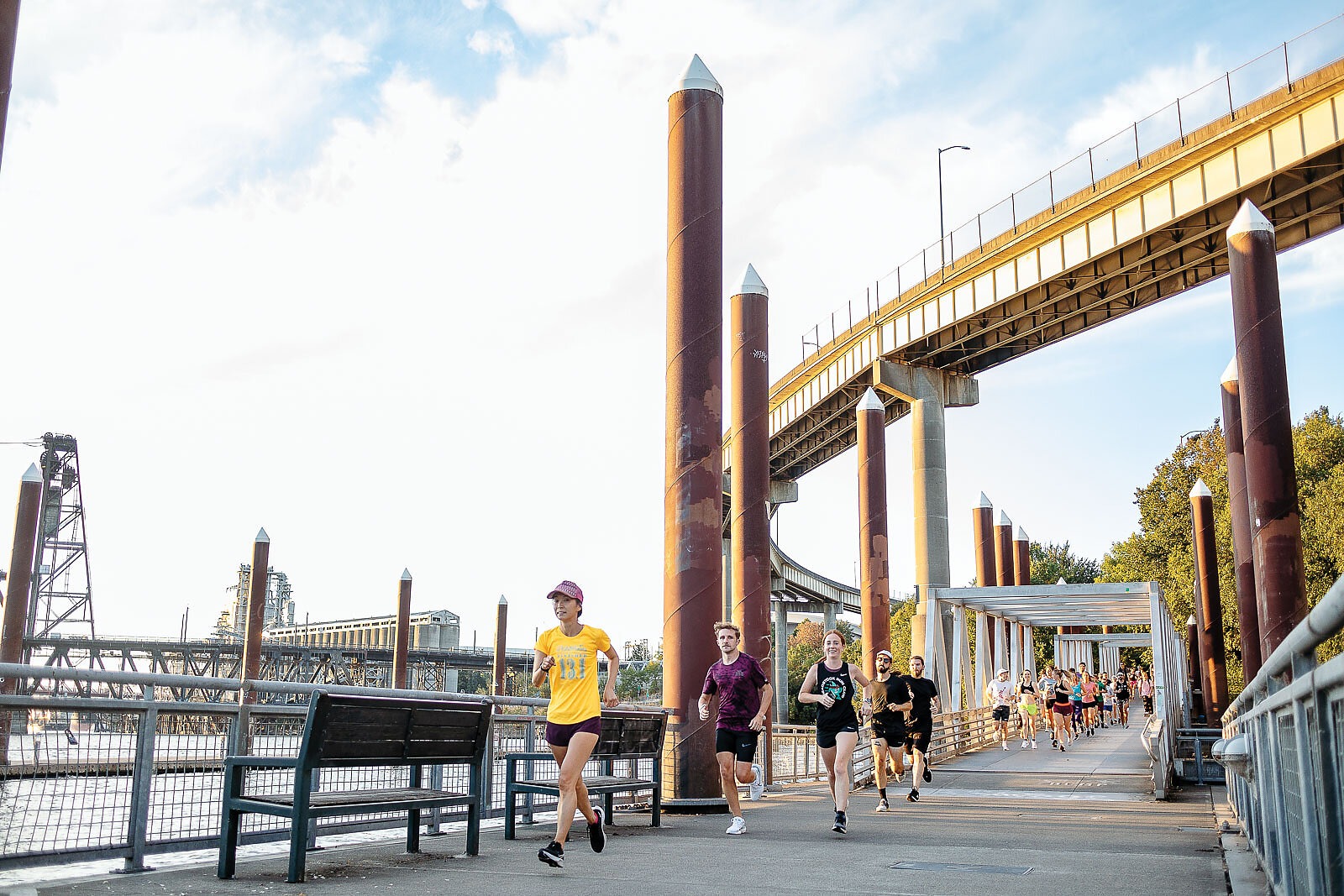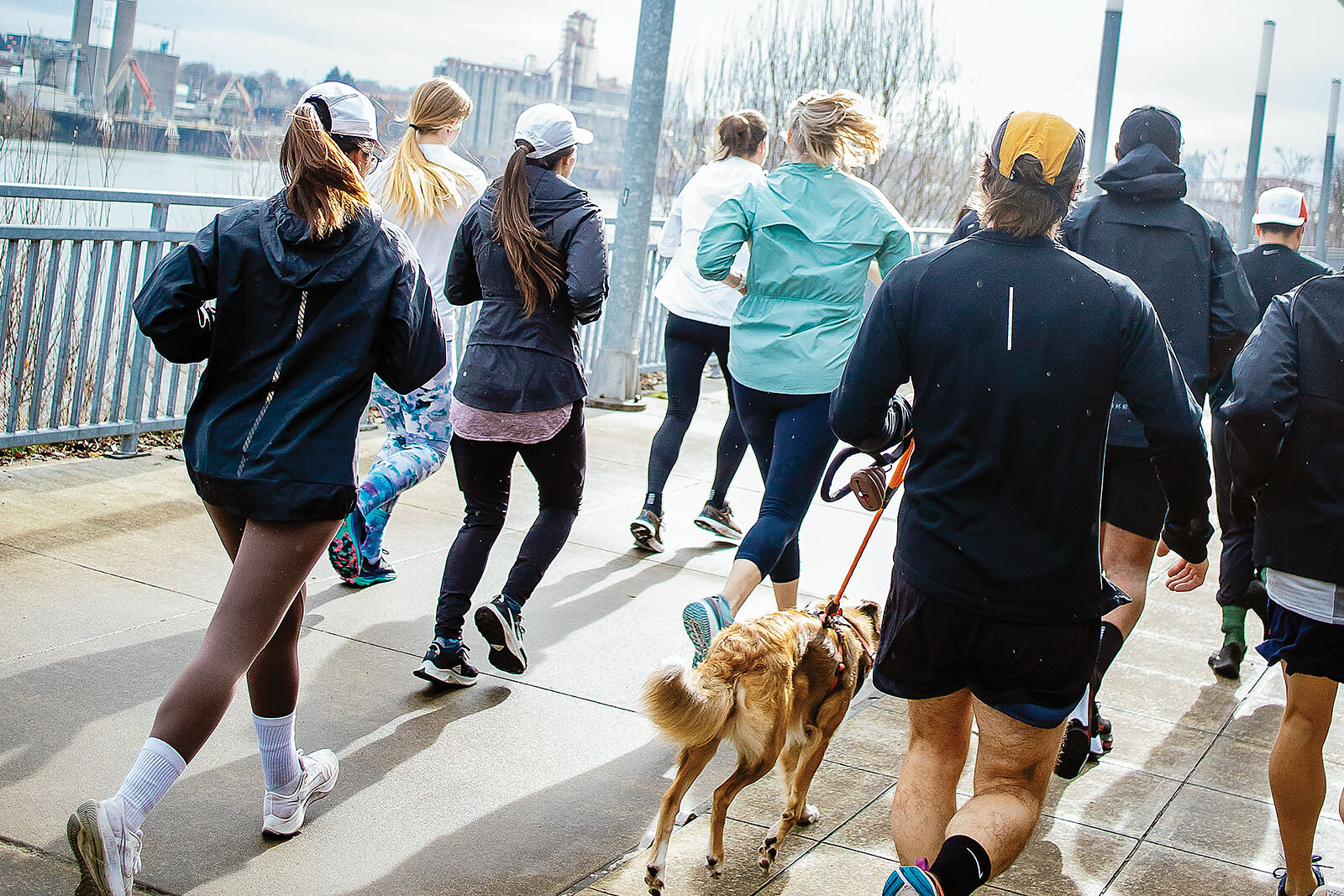
Running with the Pack The Proliferation of Run Clubs in Portland
Words by Mareshah “MJ” Jackson | Photos by Chris Dorwart
On a rainy Saturday in Portland, Oregon’s Central Eastside, runners from Stumprunners, Runaway Club, and Deadstock Run Club gather at a local coffee shop for a group run hosted by the running collective, Jacuzzi Boys. It’s a large turnout—at least three dozen and there’s a demonstration by running shoe company Hoka happening too. The group is diverse and dynamic; it’s clear some runners are having new experiences with this crew.
“This one was fast,” shared one runner after completing a four-mile route, the shortest option of the day. “Their easy pace was like an eight-minute mile!”
As the four-mile crew sipped coffee and mingled, more runners streamed in from longer journeys. They were soaking wet and cold from the 40-degree rain, but most wore gleaming smiles. The run club experience—which typically blends organized group runs with a post-jaunt social element—has long been a staple in Portland and other American cities.

While most run clubs in Portland don’t have explicit barriers to joining, many runners have experienced gatekeeping in one way or another. Intentionally or not, speed is an extremely effective gatekeeping tool. Running is notoriously intimidating for those wanting to get into the sport, says Jahan Behbahany, a board member of Stumprunners. On Saturday mornings, his group leads around 10 to 30 runners through Forest Park from the Slabtown neighborhood in northwest Portland.
“So much of the sport that’s seen is focused on distance and time-based accomplishments,” Behbahany says. “It [can] feel individualistic and competitive.”
Three days after the inter-club meetup in the Central Eastside, a few of the same people who run trails with Stumprunners join the Deadstock Run Club, which meets at its eponymous coffee shop on Tuesdays at 7 p.m. After one snowy evening run, eight runners congregated and attempted to sum up the subculture in just a few words.
“Run clubs in Portland need more diversity,” said Steven Lozano, a regular at Deadstock’s weekly runs as he ticked off an imaginary list with his fingers that ranged from racial diversity to speed diversity among participants.
People gravitate to Deadstock for its variety of distance options and its walking group, something that isn’t commonly found among Portland-area run clubs. They also gravitate to the club for the sense of community cultivated by its co-founders, Amir Armstrong and Ian Williams. Williams chose the northwest Portland neighborhood of Chinatown for his coffee shop so people could have a place to hang out in an area that was known for its streetwear and sneaker stores. Five years later, in 2021, Armstrong and Williams started the club, which absorbed the “let’s just hang out” ethos of the shop.
“It’s not just about marathons and races,” says Armstrong, who leads a 2.5-mile group every Tuesday evening. “Some groups are really into the training thing, and that’s cool, but we can really just run and kick it.”

This down-to-earth approach is appreciated even by those who enjoy a little speed. Marc Ano leads Deadstock’s 4.5-mile group—he’s a strong runner from the Midwest with a background in cycling who effortlessly floats among the fastest runners in most groups. Despite his ability, he still felt the competitive nature of some clubs took the fun out of the sport when he first started running with groups in Portland.
“Even when you can keep up with them, it isn’t a good time,” Ano said. “I wanted to be able to talk to people and make friends—not be treated like shit.”
Paige Crawford, another strong runner who recently ran the Boston to New York Women’s Expedition with FALKE Sport, has had similar experiences.
“I have had experiences where I have felt like I was not accepted as my entire person or that groups felt cliquey,” Crawford said. “When I began joining run groups five years ago, I was looking for motivation and inspiration from others, but also friends and a sense of community.”
Deadstock is a key for socializing and networking, especially among city transplants and people of color mentions Armstrong as he gestures to the group of runners huddled in the Chinatown cafe which shares a block with streetwear shops, art galleries, and a soon-to-open yoga studio. Many of the businesses around Deadstock are owned and operated by people of color who have collaborated with the coffee shop, put in miles with its club, or both.
In the Central Eastside neighborhood, another group meets for beers at Away Days Brewing after a rainy three-mile run on the waterfront. In many ways, this club, known as the Runaway Club, mirrors Deadstock’s. The co-owner of Away Days Brewing, Peter Hoppins, and Williams even collaborate on menus and events highlighting their respective worlds of sneakerhead culture and soccer. Runaway is one of Portland’s newest groups, founded by Clare Penny in 2022, and eavesdropping in on a conversation, accents from the United Kingdom, Ireland, Chile, and Germany can be heard.

“I come here for this,” says one runner from Chile who goes by JP as he looks toward other patrons at the bar, more than half of whom were there for the run club. JP was one of the first people to join the Runaway Club, attending its very first run back when it met next door at the recently-closed Toffee Club (same owners). He used to spend time at Toffee Club to catch soccer games, which is how he found Runaway Club.
“Compared to some of the other [soccer] bars, it had a cooler, more modern vibe,” JP said. The energy that makes Toffee Club-turned-Away Days his preferred spot for catching soccer games also carries over into the run club.
“It’s not as much about running as it is about socializing,” he said. His friend, an Englishman training for the London Marathon, agreed. Improving his fitness isn’t what brings him to run the waterfront loop each week.
“I used to do most of my runs alone, and I still like running alone,” he said. “But I’ve had my coach build easy Thursdays into my training program so that I can come hang out with this group of people.”
Yassine Diboun, who has a background in exercise science and co-founded Wy’east Wolfpack as a coaching program, is all too familiar with the need for inclusive experiences. He’s struggled with managing perception since his business began hosting free Thursday night social runs around 2011.
“People see that Willie [McBride, co-founder] and I do a lot of extreme things,” Diboun said. “They may think it’s cool, but they also feel like, ‘I can’t run with them. They’re going to be too fast, too intense.’ But once you get to know us, we’re very approachable, accommodating, and we try to be inclusive of everybody.”
FoPo has more than 60 regular attendees, its own merchandise, and an active digital presence. Like Diboun, Natalia sees a connection between the group’s online presence and its accessibility.
“A successful run club will work to make its activities as accessible to as many people as it can safely accommodate,” she says. “For us, this means highlighting our openness to all ability levels and our emphasis on the local community.

“Our original Thursday night social run has some spicy routes,” Diboun said with a laugh, referring to six-mile routes that take runners hundreds of feet higher in elevation. Those climbs can’t really be avoided in the neighborhood where Wy’east Wolfpack meets, especially at that distance. But to accommodate newer or less intense runners, the club has begun holding shorter, more beginner-friendly runs that go for about three miles.
Wy’east has also started to share routes ahead of time, so people feel more comfortable knowing where they’ll be running. Not only can they mentally prepare for hills, but they can also feel comfortable going at their own pace. Penny, from Runaway Club, has experience with that. While her group normally does the same waterfront loop every week, she had recently collaborated on a run that took a different course.
“[One of the regular runners] told me she didn’t come because she wasn’t sure where we’d be running,” Penny said. “She didn’t want to risk being left behind.”
A club can’t please everybody, especially when it stays connected to its neighborhood, roots, and unique flavor. In that sense, inclusivity is fostered in the sheer number of run clubs available across Portland.
You can find truly fun-loving clubs deep in southeast Portland, particularly with the FoPo Run Club. The Foster-Powell neighborhood makes a distinct wedge on a map, which the FoPo group ran every Wednesday when it first formed in 2017, says founder Natalia B. Once a small group of runners that met near Natalia’s house for neighborhood jaunts, FoPo is now one of the city’s most visible social run clubs, often boasting the largest—and loudest—presence at local races. The club sets up a cheer station during the Portland Marathon and stays until the very last runner finishes.
FoPo has more than 60 regular attendees, its own merchandise, and an active digital presence. Like Diboun, Natalia sees a connection between the group’s online presence and its accessibility.
“A successful run club will work to make its activities as accessible to as many people as it can safely accommodate,” she says. “For us, this means highlighting our openness to all ability levels and our emphasis on the local community.

Natalia still considers FoPo a space for people who live, work, and play in the southeast quadrant of Portland. Most of the club’s runs begin and end at FoPo Tavern, a local bar chosen for its ability to accommodate the group’s growth in its early years.
Though a run club’s neighborhood location can play a significant role in who it attracts and what kind of runs it becomes known for, the different “flavors” of each go beyond location. While some look to run clubs as a way to socialize, others want to push the limits of their athleticism.
“I like getting faster, pushing myself,” said Wayne Vreeland, who runs with multiple groups, including Deadstock Run Club, Stumprunners, and recently, Rose City Track Club. “I can go to different ones for different reasons. Some may not be as inclusive or social as others, but they can provide other things.”
For some new runners, navigating the running club scene isn’t always a straightforward process. With so many groups operating independently within a relatively small urban boundary, there are bound to be some mix-ups.
“The Red Lizards also meet on Thursday nights, in Goose Hollow,” Diboun shares. “Occasionally, the Goose Hollow Inn is one of our meet-up spots; one time, somebody came to what they thought was our run. They parked in Goose Hollow, saw a group of runners standing there, and they just jumped in with them. They didn’t realize until they were like three miles into the run, like, ‘Wait a minute–this isn’t Wy’east Wolfpack?’”
Of course, incidents like that are another way to learn about a group you hadn’t encountered before. Rather than remain segregated, many run clubs in Portland are collaborating at every new opportunity that pops up. Soon, it’ll be hard for different groups to be strangers to one another. There’s work to be done in cultivating the Rose City as a place any runner can find their pack in. Club organizers such as Crawford feel that run club inclusivity is on a positive trajectory.
“The run community has become more supportive recently,” Crawford says. “All-crew events, meetups, and runs … [it’s all about] connecting all runners regardless of experience or ability.”